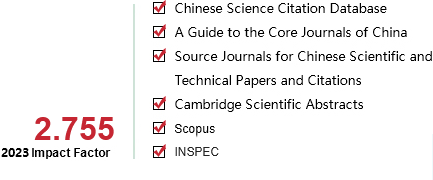[1]XU Yi,ZHANG Jie.Multi-scale decision model based on partition order product space[J].CAAI Transactions on Intelligent Systems,2024,19(6):1528-1538.[doi:10.11992/tis.202306026]
Copy
Multi-scale decision model based on partition order product space
CAAI Transactions on Intelligent Systems[ISSN 1673-4785/CN 23-1538/TP] Volume:
19
Number of periods:
2024 6
Page number:
1528-1538
Column:
学术论文—人工智能基础
Public date:
2024-12-05
- Title:
- Multi-scale decision model based on partition order product space
- Keywords:
- granular computing; rough set; multi-scale decision system; partition order product space; multilevel; multiview; lattice structure; optimal problem solving level
- CLC:
- TP18
- DOI:
- 10.11992/tis.202306026
- Abstract:
- Knowledge acquisition in multiscale decision systems is an important research problem. Existing studies on multiscale decision systems only typically address multiple scales of condition and decision attributes, but they often overlook scenarios where condition attributes have multiple views. As a new granular computing model, the partition order product space simultaneously considers multiple levels and views. Therefore, this paper uses the partition order product space to describe and solve multiscale decision problems and establishes a multiscale decision model based on this space, which is referred to as the partition order multiscale decision system. First, the study proposes a partition order multiscale decision system based on the partition order product space, which can describe multiscale decision problems from multiple views. Second, two different lattice structures within the problem solution space of the partition order multiscale decision system are provided. Third, two optimal problem-solving level selection algorithms are introduced for the two different lattice structures to address the multiscale decision problem from multiple views. Finally, the effectiveness of the proposed model and algorithms is verified through experiments.
- References:
-
[1] PAWLAK Z. Rough sets[J]. International journal of computer & information sciences, 1982, 11(5): 341-356.
[2] PAWLAK Z, SKOWRON A. Rudiments of rough sets[J]. Information sciences, 2007, 177(1): 3-27.
[3] YAO Jingtao. A ten-year review of granular computing[C]//2007 IEEE International Conference on Granular Computing. Fremont: IEEE, 2007: 734.
[4] WU Weizhi, LEUNG Y. Optimal scale selection for multi-scale decision tables[J]. International journal of approximate reasoning, 2013, 54(8): 1107-1129.
[5] GU Shenming, WU Weizhi. On knowledge acquisition in multi-scale decision systems[J]. International journal of machine learning and cybernetics, 2013, 4(5): 477-486.
[6] WU Weizhi, QIAN Yuhua, LI Tongjun, et al. On rule acquisition in incomplete multi-scale decision tables[J]. Information sciences, 2017, 378: 282-302.
[7] LI Feng, HU Baoqing, WANG Jun. Stepwise optimal scale selection for multi-scale decision tables via attribute significance[J]. Knowledge-based systems, 2017, 129: 4-16.
[8] LI Feng, HU Baoqing. A new approach of optimal scale selection to multi-scale decision tables[J]. Information sciences, 2017, 381: 193-208.
[9] WU Weizhi, LEUNG Y. A comparison study of optimal scale combination selection in generalized multi-scale decision tables[J]. International journal of machine learning and cybernetics, 2020, 11(5): 961-972.
[10] DENG Jiang, ZHAN Jianming, WU Weizhi. A three-way decision methodology to multi-attribute decision-making in multi-scale decision information systems[J]. Information sciences, 2021, 568: 175-198.
[11] ZHAN Jianming, ZHANG Kai, WU Weizhi. An investigation on Wu-Leung multi-scale information systems and multi-expert group decision-making[J]. Expert systems with applications, 2021, 170: 114542.
[12] WU Weizhi, LEUNG Y. Theory and applications of granular labelled partitions in multi-scale decision tables[J]. Information sciences, 2011, 181(18): 3878-3897.
[13] 顾沈明, 顾金燕, 吴伟志, 等. 不完备多粒度决策系统的局部最优粒度选择[J]. 计算机研究与发展, 2017, 54(7): 1500-1509.
GU Shenming, GU Jinyan, WU Weizhi, et al. Local optimal granularity selections in incomplete multi-granular decision systems[J]. Journal of computer research and development, 2017, 54(7): 1500-1509.
[14] 吴伟志, 杨丽, 谭安辉, 等. 广义不完备多粒度标记决策系统的粒度选择[J]. 计算机研究与发展, 2018, 55(6): 1263-1272.
WU Weizhi, YANG Li, TAN Anhui, et al. Granularity selections in generalized incomplete multi-granular labeled decision systems[J]. Journal of computer research and development, 2018, 55(6): 1263-1272.
[15] HUANG Zhehuang, LI Jinjin, DAI Weizhong, et al. Generalized multi-scale decision tables with multi-scale decision attributes[J]. International journal of approximate reasoning, 2019, 115: 194-208.
[16] 宋茂林, 吴伟志. 协调的决策多尺度不完备信息系统的最优尺度选择[J]. 河北师范大学学报(自然科学版), 2022, 46(2): 117-125.
SONG Maolin, WU Weizhi. On optimal scale selection in consistent incomplete multi-scale information systems with multi-scale decisions[J]. Journal of Hebei Normal University (natural science edieion), 2022, 46(2): 117-125.
[17] HAO Chen, LI Jinhai, FAN Min, et al. Optimal scale selection in dynamic multi-scale decision tables based on sequential three-way decisions[J]. Information sciences, 2017, 415/416: 213-232.
[18] ZHANG Xueqiu, ZHANG Qinghua, CHENG Yunlong, et al. Optimal scale selection by integrating uncertainty and cost-sensitive learning in multi-scale decision tables[J]. International journal of machine learning and cybernetics, 2020, 11(5): 1095-1114.
[19] CHENG Yunlong, ZHANG Qinghua, WANG Guoyin, et al. Optimal scale selection and attribute reduction in multi-scale decision tables based on three-way decision[J]. Information sciences, 2020, 541: 36-59.
[20] WANG Wenjue, HUANG Bing, WANG Tianxing. Optimal scale selection based on multi-scale single-valued neutrosophic decision-theoretic rough set with cost-sensitivity[J]. International journal of approximate reasoning, 2023, 155: 132-144.
[21] 徐怡, 姚一豫. 划分序乘积空间: 基于划分的粒计算模型[J]. 计算机研究与发展, 2019, 56(4): 836-843.
XU Yi, YAO Yiyu. Partition order product space: partition based granular computing model[J]. Journal of computer research and development, 2019, 56(4): 836-843.
[22] 吴伟志. 多粒度粗糙集数据分析研究的回顾与展望[J]. 西北大学学报(自然科学版), 2018, 48(4): 501-512.
WU Weizhi. Reviews and prospects on the study of multi-granularity rough set data analysis[J]. Journal of Northwest University (natural science edition), 2018, 48(4): 501-512.
[23] CATANZARITI F, CHIASELOTTI G, INFUSINO F G, et al. Object similarity measures and Pawlak’s indiscernibility on decision tables[J]. Information sciences, 2020, 539: 104-135.
[24] LIU Fulun, ZHANG Benwen, CIUCCI D, et al. A comparison study of similarity measures for covering-based neighborhood classifiers[J]. Information sciences, 2018, 448/449: 1-17.
[25] QIAN Yuhua, LIANG Jiye, YAO Yiyu, et al. MGRS: a multi-granulation rough set[J]. Information sciences, 2010, 180(6): 949-970.
[26] QIAN Yuhua, LIANG Jiye, DANG Chuangyin. Incomplete multigranulation rough set[J]. IEEE transactions on systems, man, and cybernetics - part A: systems and humans, 2010, 40(2): 420-431.
[27] XIE Jingjing, HU Baoqing, JIANG Haibo. A novel method to attribute reduction based on weighted neighborhood probabilistic rough sets[J]. International journal of approximate reasoning, 2022, 144: 1-17.
[28] ABDI H, WILLIAMS L J. Principal component analysis[J]. WIREs computational statistics, 2010, 2(4): 433-459. [LinkOut]
[29] POLIKAR R. Ensemble learning[M]//ZHANG Cha, MA Yunqian, eds. Ensemble Machine Learning. New York: Springer New York, 2012: 1-34.
- Similar References:
Memo
-
Last Update:
2024-11-05
